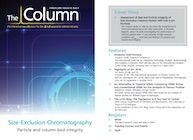Investigating the Environmental Impact of Anticoccidials
Researchers have developed a new liquid chromatography tandem mass spectrometry (LC–MS/MS) method for the simultaneous chromatographic separation and detection of anticoccidials, which are used as an agricultural animal treatment, in environmental waters.
Researchers have developed a new liquid chromatography tandem mass spectrometry (LC–MS/MS) method for the simultaneous chromatographic separation and detection of anticoccidials, which are used as an agricultural animal treatment, in environmental waters (1).
These compounds are used to control coccidiosis and other protozoan infections in agricultural animals, such as broiler chickens, and up to 95% of anticoccidials are excreted from post-treatment animals. These excreted drugs tend to be unmetabolized and remain in their parent drug form (2,3). This high percentage may be related to the nature of the issue farmers are addressing. As poultry have a high susceptibility to coccidiosis and because many poultry farms keep their animals in very closed spaces, the possibility for mass infection outbreaks is very high. The damage to the animal occurs during the asymptomatic phase causing intestinal lesions and diarrhoea, resulting in poor weight gain and poor feed conversion, and has a financial impact because the bird’s short lifespan decreases recovery time (4). It is therefore necessary to administer anticoccidials before an infection has a chance to occur. These compounds are also found in poultry manure and slurry. Anticoccidials can concentrate in the soil, make their way into surface waters, and leach into groundwater supplies, which leads to resistance issues caused by long-term exposure to low levels, and a myriad of potential eco-toxicological risks, including risk to aquatic and terrestrial organisms.
Although there has been a significant amount of work performed to develop detection methods for anticoccidials, most of these focus on food matrices. Researchers set out to develop a comprehensive chromatographic separation and detection method for the highly polar and basic anticoccidials, which historically required separation on alternative column chemistries. Researchers also wanted to include anticoccidials used outside of the EU to allow for a wider application of the technique. The resulting method used LC–MS/MS for the simultaneous separation and detection of 31 anticoccidial drugs in one single injection. Researchers also developed and optimized a sample extraction procedure based on solid-phase extraction (SPE), which was capable of extracting anticoccidial residues from raw, unfiltered environmental water samples at ppq to ppt levels.
References
1. D. Mooney et al., J. Chroma.A https://doi.org/10.1016/j.chroma.2020.460857
2. N. Broekaert et al., Anal, Bioanal. Chem.401, 3335–3344 (2011).
3. European Food Safety Authority (EFSA), J. EFSA1–45(2004).
4. M. O’Keefe, A review of Coccidiostat Residues in Poultry, SafeFood, Cork, Ireland, 2003.
A Matrix-Matched Semiquantification Method for PFAS in AFFF-Contaminated Soil
Published: April 14th 2025 | Updated: April 14th 2025Catharina Capitain and Melanie Schüßler from the Faculty of Geosciences at the University of Tübingen, Tübingen, Germany describe a novel approach using matrix-matched semiquantification to investigate per- and polyfluoroalkyl substances (PFAS) in contaminated soil.
Silvia Radenkovic on Building Connections in the Scientific Community
April 11th 2025In the second part of our conversation with Silvia Radenkovic, she shares insights into her involvement in scientific organizations and offers advice for young scientists looking to engage more in scientific organizations.






